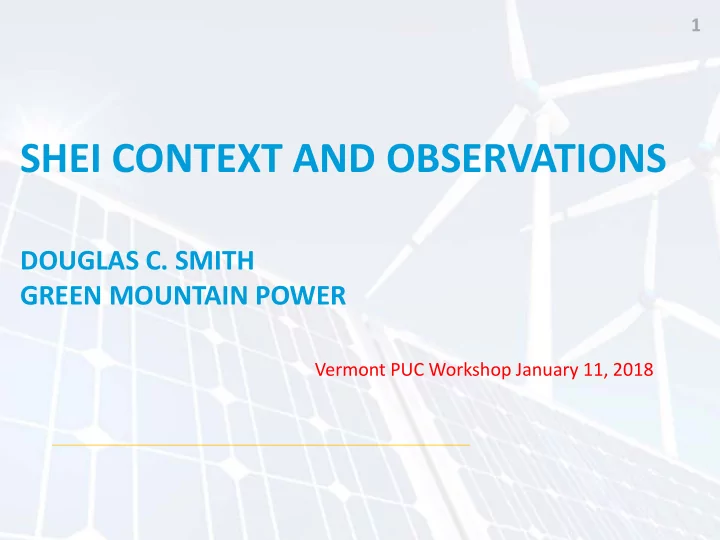

1 SHEI CONTEXT AND OBSERVATIONS DOUGLAS C. SMITH GREEN MOUNTAIN POWER Vermont PUC Workshop January 11, 2018
Discussion Themes 2 When is SHEI typically congested, and what does that mean? Implications for GMP customers Initial observations on evaluation of solutions
When is SHEI Congested? 3 Primarily when generation in the area is high Wind (Kingdom Community Wind, Sheffield) and hydro Deliveries over Highgate Converter This typically means winter & spring months And any time of year when major transmission system maintenance / outages occur During most hours of the year, SHEI is not congested Typically ~20% of the time on average, but big fluctuations (monthly, and Day Ahead vs. Real Time markets) Varies greatly by day/hour, and even within hours (real time) But typically at times when a lot of power is being produced >> significant customer value at stake
What Happens When “Congestion” Occurs? 4 Total amount of generation within SHEI area exceeds the interface limit ISO-NE monitors interface flows, if/when reductions are needed Some source(s) need to limit their output, so interface limit is not exceeded Framework governing dispatch of larger generators is known as “DNE” (Do Not Exceed) Intermittent generators (like Sheffield, KCW, Sheldon Springs) are included – starting late May, 2016 Transmission constraints are now resolved based on offer prices of resources (and other factors) Market prices (LMP) can diverge much more strongly across interfaces A significant change for the regional market (not only VT/SHEI)
Congestion in ISO-NE: One Extreme Example 5
Increased Net Costs for GMP Customers 6 When SHEI is congested, three primary mechanisms: Reduced generation output (e.g., at KCW) Lose value of energy, Renewable Energy Certificates, Production Tax Credit Almost all power generated/delivered in SHEI is renewable Lower LMP payments to generation in SHEI Affects all sources in the area, not just the one(s) being reduced Offsetting: lower cost to purchase load requirements Estimated net impact for GMP: several $million of net cost increase, over 18 months Key: in the SHEI area, much more generation than load True for VT in total, but there are exceptions Enough to justify meaningful effort on finding solutions To cost-effectively increase interface capacity >> reduce frequency & magnitude of interface congestion And to exercise caution re: addition of new generation in the area
Potential Solutions 7 A complex evaluation Electrical engineering; wholesale power markets Range of operating conditions VELCO/EIG study (Q4 2017) was a big step How much would potential solutions increase SHEI limits? Under different system conditions? Other important ingredients Breadth/depth of lost generation and congestion to date How representative was this recent history? Some potential solutions not yet scoped/studied?
Benefit/Cost Screening 8 Significant range of potential solutions Type, scale, complexity, permitting/time required Estimation of capital costs For some, also operating revenues/expenses Effectiveness of solutions in different system conditions How much would potential solutions increase SHEI limits? Under different system conditions? Ideally, an initial screening step Solution feasibility, scale, benefit/cost, timing Narrow the focus to a subset of options
Potential Solutions – Initial Themes 9 Can a mix of small/mid-size options cost-effectively address today’s SHEI congestion? Are there any solutions that should be deployed ASAP? Initial GMP evaluation: AVR at Sheldon Springs could be one Or, additional solutions that should be explored in parallel? Process for broad solution evaluation = TBD Technical/financial analysis suitable to small groups – particularly with VELCO and VDUs But need to involve other parties/stakeholders Working group, with periodic briefing to PUC?
Future Generation in SHEI Area 10 Key first step: how to cost-effectively de-congest the current system? Current generation sources and loads If additional generation is then added in SHEI, gains could be eroded An ongoing dialogue will likely be needed re: proposed future generation in the area Likely impacts (MWh, $$) on existing sources (almost all renewable) in the area Benefits of the proposed generation to VT customers Future options to mitigate congestion, and who should pay
Recommend
More recommend